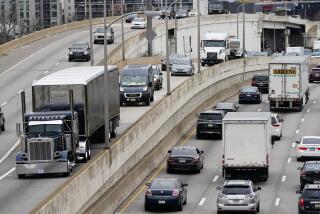Airlines Must Buy High-Tech Bomb Detectors
- Share via
WASHINGTON — In an effort to avoid a recurrence of the Pan Am Flight 103 bombing, the Federal Aviation Administration on Wednesday ordered U.S. airlines to purchase high-technology bomb detectors to screen luggage at international airports in the United States and overseas.
The devices--designed to detect hidden bombs such as the explosive-laden radio pinpointed as the device that destroyed the Pan Am 747 over Lockerbie, Scotland, last December, killing 270 people--will be deployed in several phases.
FAA spokesman John Leyden said that it is expected to take three years to supply the 40 busiest airports in the United States and abroad with 200 of the detectors.
Kennedy Gets First Detector
The first of six bomb detectors to be installed under the FAA program goes into operation Friday at TWA’s terminal at New York’s Kennedy International Airport.
Airports in San Francisco, Miami, London and Frankfurt are likely to receive four of the remaining five devices as soon as they are built, the spokesman said. The location of the sixth detector included in the initial phase has not been determined.
Negotiations are in progress with foreign governments to allow U.S. carriers to install additional detectors at airports overseas.
The FAA rule does not require a particular device but says that one called Thermal Neutron Analysis has been “shown to have the highest degree of explosives detection currently possible for detecting known civilian and military explosives, manufactured here and abroad.”
The new device was characterized by Leyden as a powerful anti-terrorist weapon. “It detects all known explosives,” he said. “We think it’s going to be very effective. There’s no panacea, (but) it’s a major step in thwarting terrorism.”
The detectors, developed by a San Diego company, Science Applications International, emit low-energy neutrons that pass through luggage and interact with chemicals in explosives. A computer sounds an alarm when a bomb is found. The firm is building the devices in Santa Clara, Calif.
Leyden said he could not speculate on when Los Angeles International Airport would receive the devices. He said that the first priority is to install the truck-sized detectors in airports that serve as hubs for travel to Europe and the Middle East, where most terrorism occurs.
The first detectors cost about $1 million each, but the next round of devices will cost around $750,000, with the price expected to drop further as production increases.
Airlines will be required to pay for the machines, Leyden said. Some carriers have protested, arguing that terrorists do not strike against airlines but against U.S. government policies and, therefore, that the government should pay.
Some questions have been raised about the ability of the thermal devices to detect all explosives. One of the device’s critics, Rep. Cardiss Collins (D-Ill.), whose Government Operations transportation subcommittee oversees the FAA, said that the units do not detect explosives directly, but only the amount of nitrogen in a suitcase.
“The smaller the amount of explosive, the more difficult it is to detect . . . the . . . nitrogen content of the suitcase. The problem is compounded because very small amounts of plastic explosives, in particular, can cause crashes and fatalities,” Collins said in a statement.
A draft rule requiring installation of the devices was issued by the government on July 6. The action Wednesday makes the rule final.
Other actions taken by the Transportation Department and the FAA after the Pan Am bombing include increased hand searching of luggage, better reporting of threats to authorities and closer screening of airline employee access to aircraft.
More to Read
Sign up for Essential California
The most important California stories and recommendations in your inbox every morning.
You may occasionally receive promotional content from the Los Angeles Times.













